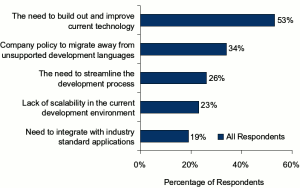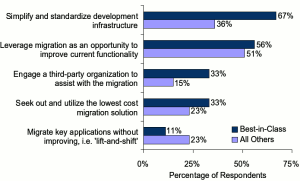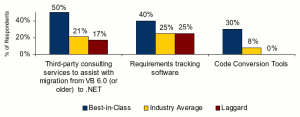
Given the unpredictable nature of today’s market climate, many software-oriented companies are scrambling to cut costs and streamline their application development processes. For organizations utilizing Microsoft Visual Basic 6.0 (VB6) as their primary development environment, the difficulty of achieving this agility was magnified by the April 8, 2008, termination of all support for VB6.
While some resource-heavier organizations have the in-house domain expertise required to manage a migration from VB6 to the newer Visual Basic.Net, many others must decide whether to forge ahead with an unsupported development platform or to offload some of the technical burden of migration onto an IT outsourcer or third-party consulting service. A 2008 Aberdeen report, “IT Infrastructure Outsourcing: Reduce Costs without Sacrificing Service,” confirms that the need to reduce IT operating costs is the No. 1 business pressure forcing companies to outsource key IT functions.
Research Background
Aberdeen surveyed IT professionals at 130 discrete organizations during November and December of 2008. These organizations provided feedback on the strategies, tactics and methods they employed to promote a smooth migration from VB6 to .Net.
The research reveals that Best-in-Class companies were able to reduce time to market of their key applications, lower the cost of software development, and achieve heightened performance of those applications. Essentially, by leveraging a wide assortment of organizational capabilities, these companies were able to deploy their technologies faster, at a lower cost, and at a higher performance level.
The Value of IT Outsourcing and Consulting
From data storage through application development and network management, IT outsourcing (ITO) and consulting services provide a broad range of solutions designed to help control costs and maintain high levels of service. Software migration, on the other hand, introduces a different set of challenges.
Oftentimes, a company’s developer workforce can become entrenched in one platform, making any transition all the more difficult from a management perspective. Aberdeen’s April 2008 ITO benchmark report indicates that the top performing companies have taken this leap and outsourced aspects of new technology integration and change management (Figure 1).
The data shows that Best-in-Class companies were almost twice as likely as Laggards to outsource the integration of new technology into their existing infrastructure and more than twice as likely as all other companies to outsource change management — including software migration. By leveraging a wide spectrum of organizational capabilities such as close SLA (service level agreement) management, these companies were able to achieve substantial reductions in IT operating costs and improvements in application uptime. These types of performance enhancements are a foundational element of maintaining IT agility and adaptability in this fluctuating economy.
Building the Case for Software Migration
Aside from the sense of urgency created by Microsoft’s termination of support for VB6, IT professionals look to migrate to a new development environment for several essential business reasons (Figure 2).
Several of the top pressures listed in Figure 2 are closely related to innovation. As companies look to make their technology more relevant and game-changing in the marketplace, they need to know that they’re building this technology on a stable, well-understood platform. Scalability is clearly another vital issue, given that maintaining a competitive position is directly tied to an organization’s ability to exploit new business opportunities that may have been traditionally out of their scope of technical capability.
Additionally, as more and more concerns related to GRC (governance, risk and compliance) mount in the organization, companies are increasingly looking for technologies and platforms that lend themselves to close monitoring and compliance with internal corporate policies, as well as external industry and government mandates. Moving away from an unsupported development environment will help pave the way for faster, more efficient product development and provide a reliable platform to maintain close corporate controls.
Best-in-Class Strategies
From a strategic level, several organizational steps can be taken in order to address the challenges listed in Figure 2. Some of these strategic actions are focused internally on the workforce, and some are more outward-facing. Aberdeen’s research reveals that the top-performing organizations, by a significant margin, are making efforts to standardize their development infrastructure in order to promote a higher degree of agility and adaptability (Figure 3).
Given the myriad development environments available today (C, C#, C++, Visual Basic, VB.Net, Java, PHP, Perl, Python, etc.) software complexity can prove to be a major barrier to productivity.
Best-in-Class companies have taken strides to strip away superfluous complexity and standardize on one development platform. Additionally, while software migration can be disruptive to an organization, it affords the opportunity to upgrade and advance the existing technology during the transition, ideally emerging with a stronger and more flexible infrastructure.
Best-in-Class organizations have prioritized this approach to software migration, while the Industry Average and Laggard organizations placed a greater emphasis on the “lift-and-shift” approach that involves no improvement during the transition. Another important consideration in this migration is the time, effort and expertise required for an efficient transition. Best-in-Class organizations have taken action to engage a third-party outsourcer or consultant to help alleviate some of the technical burdens involved in the migration.
Capabilities and Enablers
Based on the findings of the Competitive Framework and interviews with end-users, Aberdeen’s analysis of the Best-in-Class approaches demonstrates that successful software migration and use of solutions and strategies depends on a combination of specific capabilities and technology enablers. Aberdeen’s research has identified several capabilities that Best-in-Class companies leverage in order to achieve their software development goals.
- Process: Central to an organization’s ability to improve its technology is an understanding of the baseline performance, or the status quo, and the ability to recognize problems as they arise as well as modules that need to be augmented. Best-in-Class companies are 72 percent more likely than all other organizations to have defined baselines for normal application performance.
- Organization: No company has unlimited resources, and many organizations loathe redirecting efforts to a project that isn’t a direct revenue generator. However, by dedicating internal resources to support of a migration effort, organizations can place domain- and department-specific expertise — i.e., people familiar with the organizational dynamics and idiosyncrasies — in a position to facilitate a faster and more efficient transition. Best-in-Class organizations are more than twice as likely as all others to have a dedicated staff in place to assist with the software migration.
- Knowledge Management: Regardless of a company’s migration strategy (i.e., internal migration or the use of an IT outsourcer or consultant), a solid understanding of the target environment is essential to determine which applications will migrate and when. For many organizations, the decision to migrate is not an “all-or-nothing” proposition. Some core applications will need to shift to a new environment immediately, while others can be rolled in at a later date. In order to have confidence in these decisions, a solid knowledge of the target environment is necessary, and the research shows that Best-in-Class companies are 27 percent more likely than all others to have in-house .Net domain expertise in place.
- Performance Management: In order to achieve the improvements in application performance that top performing companies reported, the ability to benchmark ongoing application performance and throughput is a necessary ingredient. Product development and innovation become all the more difficult without visibility into how the applications are performing and what types of improvements are being generated. Best-in-Class companies are 63 percent more likely than all others to have implemented procedures to measure and monitor improvements in application performance.
- Technology: This writing highlights several aspects of a Best-in-Class migration strategy, particularly from an internal management perspective, that help facilitate heightened performance. Best-in-Class companies have also made efforts to incorporate several technologies and solutions to help augment this strategy.
The research shows that Best-in-Class companies are six times more likely than all other companies to use code conversion or automated porting tools in order to help accelerate part of the migration process. Additionally, Best-in-Class companies are leveraging a wide range of internal and external technology strategies to achieve substantial cost reductions and improvements in time-to-market. Some of these strategies are depicted in Figure 4.
Michael Lock is a research analyst for Aberdeen Group.
















































